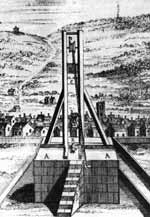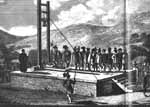
The Halifax Gibbet"From Hell, Hull and Halifax, good Lord deliver us." . |

|

|
"If a felon be taken within the liberty of Halifax...either hand-habend (caught with the stolen goods in his hand or in the act of stealing), back-berand (caught carrying stolen goods on his back), or confessand (having confessed to the crime), to the value of thirteen pence half-penny, he shall after three markets be taken to the Gibbet and there have his head cut off from his body."

|
Home |